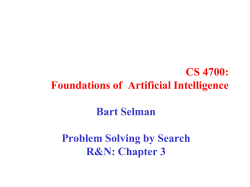
ICS 271 Fall 2014 Instructor : Kalev Kask
ICS 271 Fall 2014 Instructor : Kalev Kask Homework Assignment 1; RN Chapters 3.1-3.4 Due Tuesday, 10/21 1. (25 points) (Problem 8.1 Nilsson) In the water-jug puzzle, we are given a 3-liter jug, named T hree, and a 4 liter jug, named F our. Initially, T hree and F our are empty. Either jug can be filled with water from a tap, T , and we can discard water from either jug down a drain, D. Water may be poured from one jug into the other. There is no additional measuring device. We want to find a set of operations that will leave precisely two liters of water in Four. 1 (a) Set up a state-space search formulation of the water-jug puzzle: i. ii. iii. iv. Give the initial state description as a data structure. Define the whole state space. Give a goal condition on states as some test on data structures. Name the operators on states and give precise descriptions of what each operator does to a state description. (b) Draw a graph of all of the distinct state space nodes that are within three moves of the start node, label each node by its state description and show at least one path to each node in the graph-labeling each arc by the name of the appropriate operator. In addition to these nodes, show also all of the nodes and arcs (properly labeled) on a path to the solution. 2. (20 points) (Problem 3.9 RN) Three missionaries and three cannibals come to a river. There is a boat on their side of the river that can be used by either one or two persons. How should they use this boat to cross the river in such a way that cannibals never outnumber the missionaries on either side of the river. (a) Specify the state description, the initial state and the goal state for this problem. Describe the state space using variables (as if you are using an array in a program). Determine how many states are in state space. (b) Describe the set of operators using if-then rules. (c) Draw the entire state space graph (include only legal states, that is, states in which cannibals do not outnumber missionaries on either side of the river) (d) Describe a depth-first search algorithm and show a trace leading to a solution. 3. (15 points) (Problem 8.2 Nilsson) List the order in which nodes are visited in the tree in Figure 1 for each of the following three search strategies (choosing leftmost branches first in all cases): 1 Here’s a solution: (a) fill Three from the tap, (b) pour T hree into F our, (c) fill Three from the tap, (d) pour as much from T hree into F our as will fill it, (e) discard F our, (f) pour T hree into F our. 1 (a) Breadth-first search (b) Depth-first search (c) Depth-first iterative-deepening search (increasing the depth by 1 each iteration) 4. (15 points) (Problem 8.3 Nilsson) Consider a finite tree of depth d and branching factor b. (A tree consisting of only a root node has depth zero; a tree consisting of a root node and its b successors has depth 1; etc.) Suppose the shallowest goal node is at depth g ≤ d. (a) What is the minimum and maximum number of nodes that might be generated by a breadth-first search? (b) What is the minimum and maximum number of nodes that might be generated by a depth-fist search with depth bound equal to d? (c) What is the minimum and maximum number of nodes that might be generated by a depth-first iterative-deepening search? (Assume that you start with an initial depth limit of 1 and increment the depth limit by 1 each time no goal is found within the current limit.) 5. (10 points) (Problem 8.5 Nilsson) Assume we are searching a tree with branching factor b. However, we do not know that we are really searching a tree, so we are considering checking each state description generated to see if it matches a previously generated state description. How many such checks would have to be made in a search of the tree to depth d (including nodes at depth d)? 2
© Copyright 2025





















